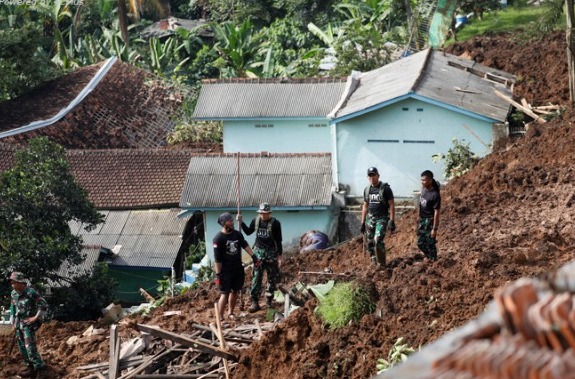Cianjur (Indonesia): Indonesian rescuers used jackhammers, circular saws and sometimes their bare hands Tuesday to shift the rubble of flattened buildings as they searched for the dead and missing from an earthquake that killed at least 268 people.
With many missing, some remote areas still unreachable and more than 1,000 people injured in the 5.6 magnitude quake, the death toll was likely to rise. Hospitals near the epicentre on the densely populated island of Java were already overwhelmed, and patients hooked up to IV drips lay on stretchers and cots in tents set up outside, awaiting further treatment.
Indonesia is frequently hit by earthquakes, many much stronger than Monday’s whose magnitude would typically be expected to cause light damage. But experts said the shallowness of the quake and inadequate infrastructure contributed to the severe damage, including caved-in roofs and large piles of bricks, concrete, and corrugated metal.
The quake was centred on the rural, mountainous Cianjur district, where one woman said her home started “shaking like it was dancing”.
“I was crying and immediately grabbed my husband and children,” said Partinem, who like many Indonesians only goes by only one name. The house collapsed shortly after she escaped with her family.
“If I didn’t pull them out, we might have also been victims,” she said, gazing over the pile of broken concrete and timber.
More than 2.5 million people live in Cianjur district, including about 175,000 in the main town of the same name.
The quake struck at a depth of 10 km (6.2 miles) and also caused panic in the capital of Jakarta, about a three hour-drive away, where high-rises swayed and some people evacuated.
National Disaster Mitigation Agency head Suharyanto, who uses one name, told reporters that 1,083 people were injured and at least 151 missing. But not all of the dead have been identified, so it’s possible some the bodies pulled from the rubble are of people on the missing list.
Rescue operations were focused on about a dozen locations in Cianjur, where people are still believed trapped, said Endra Atmawidjaja, the public works and housing spokesperson.
“We are racing against time to rescue people,” Atmawidjaja said.
Initial rescue attempts were hampered by damaged roads and bridges and power outages, and a lack of equipment to help move the heavy rubble. By Tuesday, power supplies and phone communications had begun to improve, and Atmawidjaja said that seven excavators and 10 large trucks had been deployed from neighbouring areas to clear roads.
In the village of Cijedil, the quake triggered a landslide that blocked streets and buried several houses, said Henri Alfiandi, chief of the National Search and Rescue Agency.
“We are maximising operations at several points where it is suspected that there are still casualties. Our team is also trying to reach remote areas,” he said.
Many of the dead were public school students who had finished their classes for the day and were taking extra lessons at Islamic schools when the buildings collapsed, West Java Governor Ridwan Kamil said.
More than 13,000 people whose homes were heavily damaged were taken to evacuation centres, Kamil said, though thousands spent the night in the open fearing aftershocks.
Cargo trucks carrying food, tents, blankets and other supplies from the capital, Jakarta arrived early Tuesday in temporary shelters.
Outside the Cianjur Regional Hospital, hundreds waited for treatment.
“I was working inside my office building. The building was not damaged, but as the quake shook very strongly, many things fell. My leg was hit by heavy stuff,” said Dwi Sarmadi, who works for an Islamic educational foundation in a neighbouring district.
He was waiting near a tent outside the hospital after some overwhelmed clinics were unable to see him. Many people were arriving in worse shape. “I really hope they can handle me soon,” he said.
Hasan, a construction worker who uses one name, was also taken to the hospital.
“I fainted. It was very strong,” Hasan recalled. “I saw my friends running to escape from the building. But it was too late to get out, and I was hit by the wall.” President Joko Widodo visited Cianjur on Tuesday and pledged to rebuild infrastructure, including the main bridge connecting Cianjur to other cities, and to provide government assistance up to 50 million rupiah ($3,180) to each resident whose house was damaged.
“On behalf of myself and on behalf of the government, I would like to express my deep condolences to the victims and their families in this Cianjur earthquake,” he said after visiting survivors in shelters on a soccer field.
The country of more than 270 million people is frequently struck by earthquakes, volcanic eruptions and tsunamis because of its location on the arc of volcanoes and fault lines in the Pacific Basin known as the “Ring of Fire”.
In February, a magnitude-6.2 earthquake killed at least 25 people and injured more than 460 in West Sumatra province. In January 2021, a magnitude-6.2 earthquake killed more than 100 people and injured nearly 6,500 in West Sulawesi province.
A powerful Indian Ocean quake and tsunami in 2004 killed 230,000 people in a dozen countries, most of them in Indonesia.


